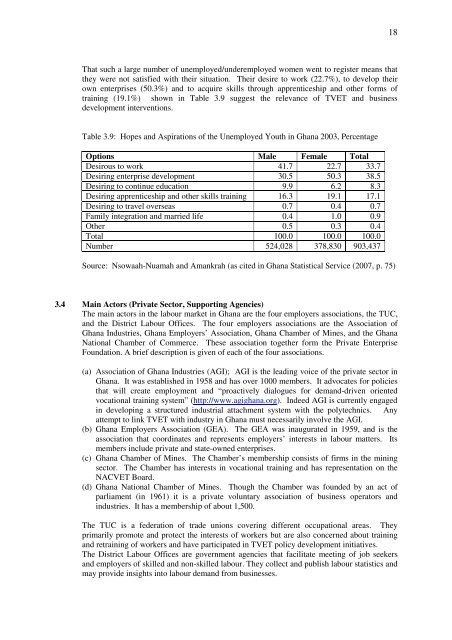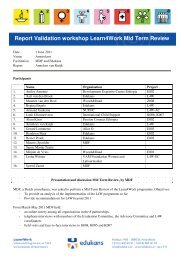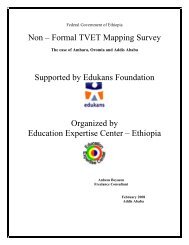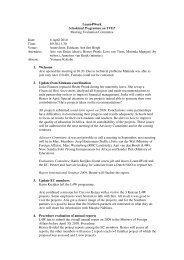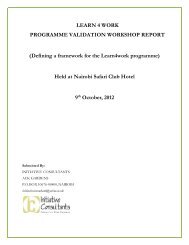DRAFT TECHNICAL AND VOCATIONAL EDUCATION AND ...
DRAFT TECHNICAL AND VOCATIONAL EDUCATION AND ...
DRAFT TECHNICAL AND VOCATIONAL EDUCATION AND ...
Create successful ePaper yourself
Turn your PDF publications into a flip-book with our unique Google optimized e-Paper software.
18<br />
That such a large number of unemployed/underemployed women went to register means that<br />
they were not satisfied with their situation. Their desire to work (22.7%), to develop their<br />
own enterprises (50.3%) and to acquire skills through apprenticeship and other forms of<br />
training (19.1%) shown in Table 3.9 suggest the relevance of TVET and business<br />
development interventions.<br />
Table 3.9: Hopes and Aspirations of the Unemployed Youth in Ghana 2003, Percentage<br />
Options Male Female Total<br />
Desirous to work 41.7 22.7 33.7<br />
Desiring enterprise development 30.5 50.3 38.5<br />
Desiring to continue education 9.9 6.2 8.3<br />
Desiring apprenticeship and other skills training 16.3 19.1 17.1<br />
Desiring to travel overseas 0.7 0.4 0.7<br />
Family integration and married life 0.4 1.0 0.9<br />
Other 0.5 0.3 0.4<br />
Total 100.0 100.0 100.0<br />
Number 524,028 378,830 903,437<br />
Source: Nsowaah-Nuamah and Amankrah (as cited in Ghana Statistical Service (2007, p. 75)<br />
3.4 Main Actors (Private Sector, Supporting Agencies)<br />
The main actors in the labour market in Ghana are the four employers associations, the TUC,<br />
and the District Labour Offices. The four employers associations are the Association of<br />
Ghana Industries, Ghana Employers’ Association, Ghana Chamber of Mines, and the Ghana<br />
National Chamber of Commerce. These association together form the Private Enterprise<br />
Foundation. A brief description is given of each of the four associations.<br />
(a) Association of Ghana Industries (AGI); AGI is the leading voice of the private sector in<br />
Ghana. It was established in 1958 and has over 1000 members. It advocates for policies<br />
that will create employment and “proactively dialogues for demand-driven oriented<br />
vocational training system” (http://www.agighana.org). Indeed AGI is currently engaged<br />
in developing a structured industrial attachment system with the polytechnics. Any<br />
attempt to link TVET with industry in Ghana must necessarily involve the AGI.<br />
(b) Ghana Employers Association (GEA). The GEA was inaugurated in 1959, and is the<br />
association that coordinates and represents employers’ interests in labour matters. Its<br />
members include private and state-owned enterprises.<br />
(c) Ghana Chamber of Mines. The Chamber’s membership consists of firms in the mining<br />
sector. The Chamber has interests in vocational training and has representation on the<br />
NACVET Board.<br />
(d) Ghana National Chamber of Mines. Though the Chamber was founded by an act of<br />
parliament (in 1961) it is a private voluntary association of business operators and<br />
industries. It has a membership of about 1,500.<br />
The TUC is a federation of trade unions covering different occupational areas. They<br />
primarily promote and protect the interests of workers but are also concerned about training<br />
and retraining of workers and have participated in TVET policy development initiatives.<br />
The District Labour Offices are government agencies that facilitate meeting of job seekers<br />
and employers of skilled and non-skilled labour. They collect and publish labour statistics and<br />
may provide insights into labour demand from businesses.


